As marketers, we’re making important decisions on behalf of our company and team every day. In addition to using our best judgment when it comes to making these decisions, it’s ideal to also utilize data and metrics when we can.
Now, you’re likely already tracking marketing metrics such as traffic, leads, and customers — these are all critical parts of the bigger picture of your marketing funnel and flywheel. But as critical as these metrics are, they’re not enough to inform broader marketing decisions that impact your entire organization.
This is where marketing reporting comes into play. This guide will help you further explore the marketing reports you can run to properly analyze your data and make truly informed decisions.
Marketing reports vary depending on what data you’re reviewing and the purpose of each report. They can assess where your traffic and leads are coming from, what content they interacted with, if and when they converted, and how long it took for them to become a customer.
To reiterate: Marketing reports inform decisions. You wouldn’t run a marketing report to review data performance or check on an ongoing goal — for these purposes, you’d glance at your marketing dashboards.
Let’s look at it this way. Compiling a marketing report for knowledge’s sake is synonymous with scheduling a meeting to simply review a project. Who likes to attend a 30-minute meeting to simply review what could've been shared via email? Not me.
The same goes for marketing reporting. Reports should help you make a decision or come to an important conclusion — similar to how a meeting would help your team deliberate about a project or decide between project resources.
In short, marketing reporting is a highly valuable process if used and crafted properly. In the next section, we’ll dive into how to build a marketing report.
How to Build a Marketing Report
As we said above, there are plenty of different marketing reports you can run; we’ll be reviewing some examples in the next section. For this reason, this section won’t focus on what specific data to put into your marketing report — that will depend on what type you decide to run. (Remember, if you’re building a marketing dashboard, that process is a bit different.)
We’re going to discuss how to build marketing reports that inform your decisions and benefit your audience (whether that’s your team, CEO, or customers).
Most of your marketing reports will contain a few of the same elements:
- Title. What is your marketing report analyzing? Whether you’re running a report on campaign performance, quarterly blog performance, or monthly leads, be sure to title your report so the intent is clear. This is especially important if you’re sharing your report with people outside of marketing.
- Reporting period. Your marketing report should reflect a certain time period. This period can be a few days, months, or even years. Analyzing your data within a time period allows you to compare performance to past periods.
- Summary. Your report summary should reflect the key points of your report, including your wins, losses, and goals for the next reporting period. It’s basically the TL;DR of your report.
Next, let’s dive into the report specifics. Valuable, insightful marketing reports recognize two distinct components: purpose and audience.
Choosing a Purpose for Your Marketing Report
A marketing report should help you make a decision. Choosing the intent of your marketing report (i.e. the data you’re analyzing) is simple; however, it’s how you’re going to use this data to make a decision or draw a conclusion that’s more difficult.
This is true for two reasons:
- Marketing reporting is more often than not performed to simply review data, which is a waste of time.
- Data points can be used to draw multiple conclusions or make multiple decisions, so you should know precisely how you’re going to use the data before you draw it.
You should determine the goal of your marketing report before you pull any data. Once you make this impending decision, list all the data that might be relevant. From there, you’ll have a much better idea of what reports to run and how to use said data.
Choosing an Audience for Your Marketing Report
Marketing reports are highly valuable because they can inform so many different decisions — decisions made by a wide variety of people across your organization. Whether you’re delivering a marketing report to your team lead, department manager, or CEO, your marketing report must be tailored to whoever may be reading and using it.
Here are a few ways to do this:
- Ask your audience what they need. If you know the decisions your audience needs to make, you’ll know what data you need to pull and analyze. Knowing this will also help you avoid running reports your audience doesn’t care about.
- Speak in their language. Marketing involves a lot of acronyms and jargon. While your team members understand what you’re saying, your executive team and co-workers outside Marketing may not be so fluent. Consider your audience when writing your marketing report and be sure to choose words and descriptions that they’ll understand.
- Don’t mix audiences. If you’re creating a marketing report for a mixed audience, it’s best to create separate reports for separate audiences. For example, you wouldn’t create the same report to give your CEO and Marketing co-workers; you’d likely break this into two reports with different data and verbiage. This will allow your audience to be able to focus on the data and analysis that’s most relevant to them.
Marketing reporting can take up a lot of your time. Here are some best practices to help you work smarter, not harder.
1. Schedule your marketing reports.
Whether you create a recurring reminder on your calendar or set your reports to automatically run, schedule your marketing reports ahead of time. This will take the guesswork out of when to run your reports and when to send them to the relevant audiences.
2. Collect feedback from your audience.
As you send out your marketing reports, ask for feedback from your audience. Whether you ask an open-ended question like, “How did this report help you?” or provide a short Google Form, gathering feedback from those using your reports can help you improve them in the future.
3. Create marketing report templates.
If your marketing report will be designed the same way each and every time you send it out, consider turning it into a template. This will save you time and energy building each template and provide a reliable, predictable report design for your audience to read.
Make your monthly reporting faster and easier with these free monthly marketing reporting templates.
4. Put your most valuable data first.
Long marketing reports are fine as long as all the data you include is valuable and helpful for whatever decision you or your team need to make. However, you should place the most impactful data first so that your audience can stop reading once they’ve made up their minds. Nobody wants to read an entire report to only utilize the final page.
5. Visualize your data as much as possible.
Did you know that humans process visual data 60,000x faster than written data? Illustrated data (e.g. graphs and charts) are also more believable, according to this study by Cornell University.
When possible, include visual data in your marketing reports. Not only does this help your reports pack a greater punch with your coworkers and executives, but it trims down the time and effort needed to digest your data. To do this, include charts from Excel or screenshots from your reporting tools (like HubSpot Marketing Hub). You can also use heat maps if you’re reporting on website performance.
Marketing Reporting Examples
There are hundreds of reports that you can run to dig into your marketing efforts. At this point, however, you’re likely asking, “Where should I start? What are those basic marketing reports I can run to get more comfortable with all the data I’ve been tracking?”
Well, we’ve pulled together these five marketing reporting examples for you to use to get started.
Note that you will need some type of marketing software (like HubSpot Marketing Hub) to do this. You should also make sure your software allows you to export the data from your software and manipulate it in Excel using pivot tables and other functions.
Since we use HubSpot for our reporting needs, I'll show you how to compile these reports using the Marketing Hub tool. (The data below is sample data only and does not represent actual HubSpot marketing data.)
1. Multi-Touch Revenue
As a marketer, you’re a big part of your company’s growth. But unless you can directly tie your impact to revenue, you’ll be forever underappreciated and under-resourced. With multi-touch revenue attribution, you tie closed revenue to every marketing interaction — from the first-page view to the final nurturing email.
That way, marketers get the credit they deserve and marketing execs make smarter investments rooted in business value instead of vanity metrics. As a bonus, multi-touch revenue attribution can help you stay aligned with your sales team.
HubSpot customers can create multi-touch attribution reports quickly; HubSpot’s attribution tool is built for real people, not data scientists. (It also connects every customer interaction to revenue, automatically.) Navigate to your dashboard, and click Add Report > Attribution Report. Select from the set of pre-baked best-practice templates, or create a custom report of your own.
Note: Enterprise HubSpot customers can do this in their software if they have their Salesforce integration set up with Account Sync turned on.
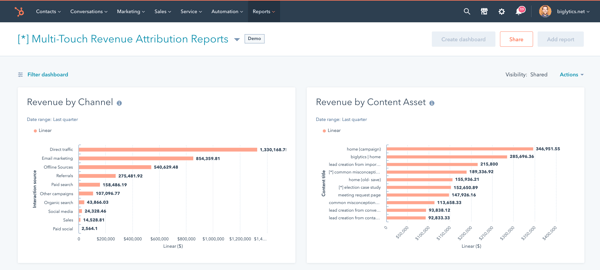
How to Analyze Revenue Reporting
To analyze revenue reporting, figure out what’s working and double down on it. Look at the revenue results from different channels and see where you had the most success. Use this information to decide what marketing efforts to invest in moving forward. For example, if you notice that your Facebook campaigns drove a ton of revenue, run more Facebook campaigns!
Multi-touch attribution reports should be run monthly to understand the broader business impact of your marketing channels. While revenue is important, you should also dig into some of your other metrics for a more complete picture.
2. Channel-Specific Traffic
Understanding where your traffic is coming from will help you make strategic decisions as you invest in different marketing channels. If you see strong performance from one particular source, you may want to invest more resources in it. On the other hand, you may actually want to invest in some of the weaker channels to get them on pace with some of your other channels. Whatever you decide, source data will help you figure that out.
HubSpot customers can use the Traffic Analytics report (under Reports > Analytics tools in your navigation) to break down traffic by source.
Want to get an even deeper understanding of your traffic patterns? Break down your traffic by geography. (Example: Which sources bring in your most traffic, in Brazil?) You can also examine subsets of your website (like your blog vs. your product pages).
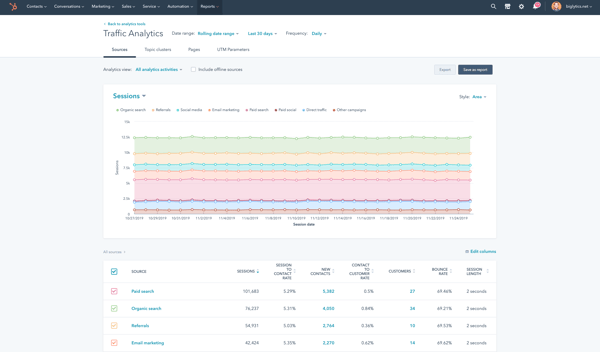
How to Analyze Channel-Specific Traffic
Take a look at what channels are performing well. Based on your goals, that could mean looking at the visitor data or focusing on the visit-to-lead and lead-to-customer conversion rates. Here are a couple of different ways to think about your data:
- If you get a lot of traffic from a certain channel, but the channel is not necessarily helping your visitors move down the funnel, it may mean that you should invest more in other channels or optimize that underperforming channel for conversion.
- Think about how you can invest resources in your strongest channels. Did you run a campaign that helped the channel perform well? Was there a piece of content you created that set it off? Consider how you can replicate your past success.
- If you haven't worked on a particular channel, it could be a good time to test it out. Think about how you can incorporate multiple channels into the same campaign.
Pulling this data weekly will allow you to stay up-to-date on how the channels are performing. If a channel took a turn for the worse, you'll have enough time to remedy the situation before it gets out of control or you waste resources. Pulling the report daily may be a bit overboard since some channels take multiple days to be effective and pulling it monthly would prevent you from responding with agility — so, weekly data is ideal.
3. Blog Posts by Conversion
Blogs have become a marketer's best friend. There’s a direct correlation between how often a company blogs and the number of leads they generate (not just the amount of traffic they drive). So, it's critical you monitor how well your blog is helping you grow that critical metric.
Reporting on your blog leads is a quick way to see how many leads you're generating on a daily, weekly, or monthly basis — and by what channel. This report is a great way to understand what channels are strongest for your blog, where you should spend more promotion time, and how well your content is performing over time.
If you're using HubSpot, creating a blog leads report is easy. Navigate to Add Report from any of your dashboards, and choose Top blog posts by contact conversion. This report shows the posts that were most often seen by contacts immediately before filling out a form on your website.

How to Analyze Blog Posts by Conversion
Look at how many leads you're generating from your blog over time. If you see spikes in leads, you know to dig into your content to see if certain topics are more successful at generating leads than others. The more you can run these reports to figure out what works and what doesn't work, the better off your marketing and blogging will be.
This type of data should be pulled on a monthly basis to ensure you’re writing the most relevant content over time.
4. New Contacts by Persona
Every marketer needs to be well-versed in their buyer personas — but you need to do more than just understand them. It's important to track how many new contacts you're actually adding to your database based on each persona. This will help you determine how accurate your buyer personas are and how successful your marketing is in targeting and reaching them.
To report on this in HubSpot, plot your contacts by Create date, which will show the date on which you added a new contact to your database. Then, break down your report by persona.
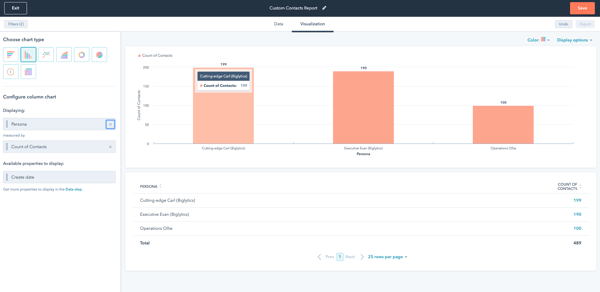
How to Analyze New Contacts by Persona
Did you run a marketing campaign around a particular topic? Did you focus on promoting your content through specific channels? What did you do that led to an increase or decrease in persona acquisition? Digging into this report can help you allocate resources more wisely to grow different segments of your business.
Pulling this report on a monthly basis can give you insight into how your campaigns affect new contacts by persona — and might even shed light on an imbalance in resources dedicated to certain personas.
5. Lifecycle Stage Funnel
Another way to segment your contact database is to look at how they appear by lifecycle stage. This will give you a sense of how many leads, subscribers, customers, and opportunities you have in your database in a certain time period. This data will help you understand if you need to generate more leads or if you should be more focused on closing your current leads. It will also give you a general understanding of the quality of your contact database.
As a HubSpot customer, create a funnel report by clicking Add Report from any dashboard, then choosing the Funnels category. Pick which stages you’d like to include, select your visualization, and you’re off and running.
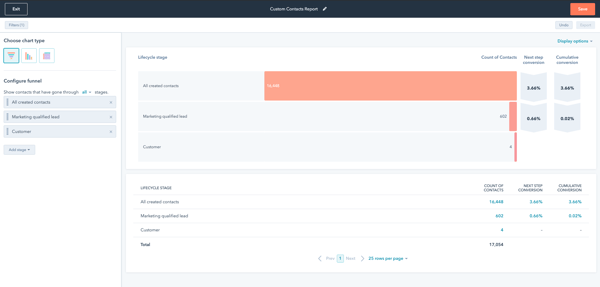
How to Analyze a Lifecycle Stage funnel
This report will give you an overview of how your leads are progressing through the buying process. Use this report to see what areas of your funnel you need to address for greater efficiency.
For example, if your report shows that you’re doing a great job of generating leads, but not converting any to MQLs, update and optimize your nurturing program. Pulling monthly funnel reports can help you stay on top of the efficiency of your marketing process
Marketing Reporting Helps You Grow Better
Marketing reporting is a vital part of your marketing efforts and the growth of your business. By understanding how efficient and effective your marketing is, you can better allocate time, resources, and money — and make well-informed decisions, to boot. Start with these marketing reporting examples and expand your reporting as you begin to utilize more data.
Editor's note: This post was originally published in April 2014 and has been updated for comprehensiveness.
from Marketing https://ift.tt/2OmKVJd
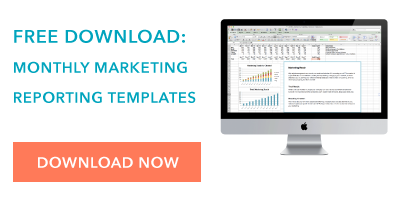

No comments:
Post a Comment